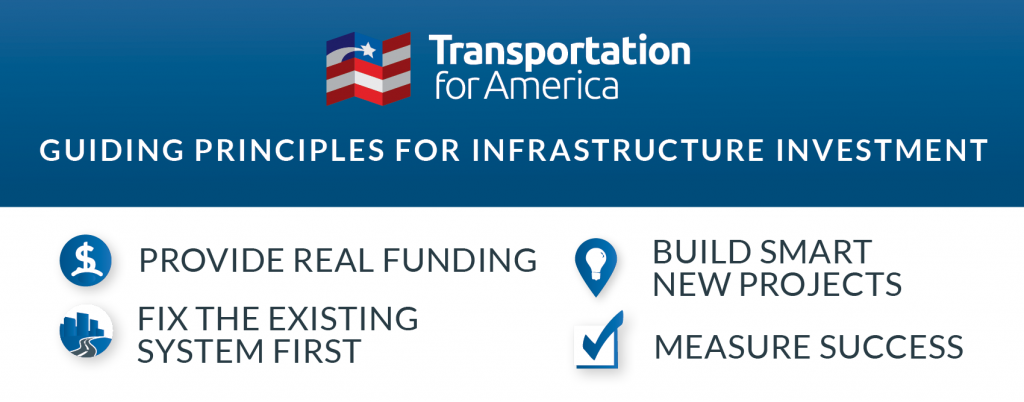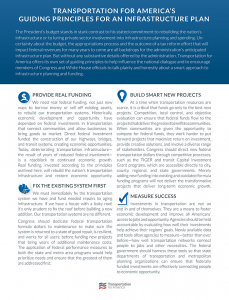
Transportation for America’s guiding principles for an infrastructure plan
As we continue to await either broad principles or specifics of the Trump’s administration much-anticipated infrastructure plan, T4America has released these four simple guiding principles to inform and evaluate any such future plan.
It’s past time to elevate the national conversation about infrastructure beyond just the breadth and cost of it. We need an examination of exactly which projects we are investing in and why. Whether the $50 billion we currently spend each year or the $1 trillion originally suggested by the administration, we need to do more than just pour money into the same old system for planning and building transportation projects.
America’s current federal transportation program does not bring us the returns we deserve for the sums we invest. There’s far too little accountability for accomplishing anything measurable and tangible with the billions we spend.
We urgently need a new way of doing business.
To get us there and truly realize the benefits of robust federal transportation infrastructure investments, we need a renewed focus on fixing our existing system first and foremost, on investing new dollars in only the smartest projects, and on creating new mechanisms to measure what we get in return for our money.
In lieu of any substantive details offered by the administration, Transportation for America offers its own set of guiding principles to help inform or evaluate any standalone infrastructure bill, aimed at influencing the national dialogue and encouraging members of Congress and White House officials to talk plainly and honestly about a smart approach to infrastructure planning and funding. They are:
1 – Provide real funding
We need real federal funding, not just new ways to borrow money or sell off existing assets, to rebuild our transportation systems. Historically, economic development and opportunity have depended on federal investments in transportation that connect communities and allow businesses to bring goods to market. Direct federal investment funded the construction of our highways, bridges, and transit systems, creating economic opportunities. Today, deteriorating transportation infrastructure—the result of years of reduced federal investment—is a roadblock to continued economic growth. Real funding, invested according to the principles outlined here, will rebuild the nation’s transportation infrastructure and restore economic opportunity.
2 – Fix the existing system first
We must immediately fix the transportation system we have and fund needed repairs to aging infrastructure. If we have a house with a leaky roof, it’s only prudent to fix the roof before building a new addition. Our transportation systems are no different.
Congress should dedicate federal transportation formula dollars to maintenance to make sure the system is returned to a state of good repair, is resilient, and works for all users; before funding new projects that bring years of additional maintenance costs. The application of federal performance measures to both the state and metro area programs would help prioritize needs and ensure that the greatest of them are addressed first.
3 – Build smart new projects
At a time when transportation resources are scarce, it is critical that funds go only to the best new projects. Competition, local control, and objective evaluation can ensure that federal funds flow to the projects that deliver the greatest benefit to communities. When communities are given the opportunity to compete for federal funds, they work harder to put forward projects that maximize return on investment, provide creative solutions, and involve a diverse range of stakeholders. Congress should direct new federal transportation dollars through competitive processes, such as the TIGER and transit Capital Investment Grant programs, which are accessible directly to city, county, regional, and state governments. Merely adding new funding into existing and outdated formula funding programs will not deliver the transformative projects that deliver long-term economic growth.
4 – Measure success
Investments in transportation are not an end in and of themselves. They are a means to foster economic development and improve all Americans’ access to jobs and opportunity. Agencies should be held accountable by evaluating how well their investments help achieve their regions’ goals. Newly available data and tools allow agencies to measure—better than ever before—how well transportation networks connect people to jobs and other necessities. The federal government should harness these tools so that state departments of transportation and metropolitan planning organizations can ensure that federally funded investments are effectively connecting people to economic opportunity.
Download these principles as a sharable one-page PDF here or by clicking below:





